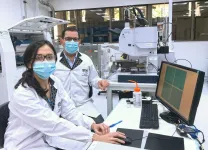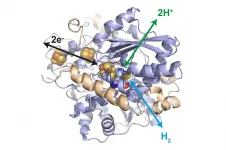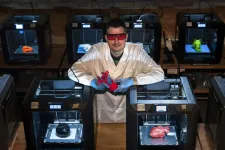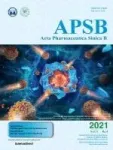(Press-News.org) Intelligent materials, the latest revolution in the field of materials science, can adapt their properties depending on changes in their surroundings. They can be used in everything from self-healing mobile phone screens, to shape-shifting aeroplane wings, and targeted drug delivery. Delivering drugs to a specific target inside the body using intelligent materials is particularly important for diseases like cancer, as the smart material only releases the drug payload when it detects the presence of a cancer cell, leaving the healthy cells unharmed.
Now, researchers from the Centre for Advanced 2D Materials (CA2DM) at the National University of Singapore (NUS) have created a new class of intelligent materials. It has the structure of a two-dimensional (2D) material, but behaves like an electrolyte - and could be a new way to deliver drugs within the body.
Just like traditional electrolytes, these new "2D-electrolytes" dissociate their atoms in different solvents, and become electrically charged. Furthermore, the arrangement of these materials can be controlled by external factors, such as pH and temperature, which is ideal for targeted drug delivery. The 2D-electrolytes also show promise for other applications that require a material to be responsive to environmental changes, such as artificial muscles and energy storage.
The team behind the 2D-electrolytes is led by Professor Antonio Castro Neto, Director of CA2DM, and comprised researchers from CA2DM, as well as the NUS Department of Physics, and the NUS Department of Materials Science and Engineering.
Their trailblazing results were published in the prestigious journal Advanced Materials on 12 May 2021.
Changing the behaviour of 2D materials
In materials science, a 2D material is a solid material that exists in a single layer of atoms. It can be thought of as an atomically-thin sheet that has a specific height and width, but effectively no depth, hence, it is essentially two-dimensional. On the other hand, an electrolyte is a substance that produces an electrically conducting suspension when dissolved in a solvent, such as water.
There are numerous 2D materials in existence today, and electrolytic behaviour has been well-established in countless other compounds. However, the results from the NUS researchers show the first instance of materials that have both 2D structure and properties of electrolytes, with a particular trend to shape shift their form reversibly in liquid medium. The NUS team achieved this feat by using organic molecules as reactive species to add different functionalities to 2D materials such as graphene and molybdenum disulfide (MoS2).
"By adding different chemical groups that become positively or negatively electrically charged in solvents, we altered traditional 2D materials and came up with a novel class of smart materials that have their electronic properties controlled by morphological conformation," explained Prof Castro Neto.
The methods used by the researchers to create 2D-electrolytes are only a few possible examples among many potential options, making this discovery an exciting new research area to explore.
From a flat sheet to a rolled-up scroll
A major breakthrough of this research was that the orientation of the 2D-electrolytes could reversibly change by tweaking the external conditions. Currently, the electrical repulsion between the surface charge in a 2D material leads to it be laid out in a flat sheet. By altering the pH, the temperature, or the ionic concentration of the suspensions, the NUS researchers demonstrated the ability of the 2D-electrolyte sheet to shape shift and form scroll-like arrangements. These experimental results are supported by detailed theoretical analysis in which they explain the physical mechanism behind the scroll formation and stability.
These scroll orientations have such a small diameter that they could be described as one-dimensional (1D), leading to different physical and chemical properties. Moreover, this transition from 2D to 1D is reversible by altering the external conditions back to their original values
"One can think of 2D-electrolytes as the higher dimensional analogues of 1D electrolytes, commonly known as polyelectrolytes," said Prof Castro Neto. Important examples of polyelectrolytes include many biologically relevant materials, such as DNA and RNA.
"When acids, bases, or salts are added, these electrically charged polymers also undergo conformational transitions from molecular chains that are 1D to globular objects of 0D, and vice versa. Our 2D-electrolytes, in analogy with polyelectrolytes, show reversible transitions from 2D to 1D, as a function of external factors. As stimuli responsive materials, they are suitable for the creation of cutting-edge technology," he added.
Next steps
Discovering this class of materials has opened up new areas of exploration for materials scientists, since it brings together two fields of research that have been traditionally unlinked, namely, 2D materials in the field of Physics, and electrolytes (in the area of Electrochemistry).
"There is an uncountable number of ways to functionalise graphene and other 2D materials to transform them into 2D-electrolytes. We hope that our work will inspire scientists from different fields to further explore the properties and possible applications of 2D-electrolytes. We anticipate that as 2D-electrolytes have similarities with biological or natural systems, they are capable of spontaneously self-assemble and cross-link to form nanofibers that are promising for applications in filtration membranes, drug delivery, and smart e-textiles," explained Prof Castro Neto.
INFORMATION:
Researchers at the Francis Crick Institute and the Latvian Institute of Organic Synthesis have designed a drug-like compound which effectively blocks a critical step in the malaria parasite life cycle and are working to develop this compound into a potential first of its kind malaria treatment.
While drugs and mosquito control have reduced levels of malaria over recent decades, the parasite still kills over 400,000 people every year, infecting many more. Worryingly, it has now developed resistance to many existing antimalarial drugs, meaning new treatments that work in different ways are urgently needed.
In their research, published in PNAS, the scientists developed a set of compounds designed to stop the parasite being able to burst out of red ...
Multiple sclerosis, or MS for short, manifests itself slightly differently in each person - which is why some call it "the disease of a thousand faces." Arguably the worst manifestation of MS is its chronic progressive form. Unlike the more common relapsing-remitting variant (RRMS), in which sufferers are often symptom-free for months or even years, patients with the primary progressive form of the disease (PPMS) see their condition steadily deteriorate with no remissions.
Poorly insulated neurons die off
Today's therapeutic approaches are based on the assumption that the immune system is making a mistake and waging an inappropriate attack on the layer of myelin that surrounds and insulates the nerve cells' long, ...
AdaptiFont has recently been presented at CHI, the leading Conference on Human Factors in Computing.
Language is without doubt the most pervasive medium for exchanging knowledge between humans. However, spoken language or abstract text need to be made visible in order to be read, be it in print or on screen.
How does the way a text looks affect its readability, that is, how it is being read, processed, and understood? A team at TU Darmstadt's Centre for Cognitive Science investigated this question at the intersection of perceptual science, cognitive ...
A giant mosasaur from the end of the Cretaceous period in Morocco that could have reached up to eight metres long is the third new species to be described from the region in less than a year, bringing the total number of species up to at least 13.
The high diversity of the fauna shows how mosasaurs, giant marine lizards related to snakes and Komodo dragons, thrived in the final million years of the Cretaceous period before they, and most of all species on Earth, were wiped out by the impact of a giant asteroid 66 million years ago.
The new species, named Pluridens serpentis, had long, slender jaws with over a hundred sharp, ...
Modern vaccines such as those against Sars-CoV-2 use tiny lipid spheres to transport genetic information into cells and let the body build up an immune defense against the virus. A team of scientists from Erlangen, Dresden, and London has now developed a completely new method to very efficiently deliver not only genes but also drugs and other substances into cells. The researchers from the Max-Planck-Zentrum für Physik und Medizin (MPZPM) in Erlangen, the Technical University of Dresden, and The Institute of Cancer Research in London have named the method Progressive Mechanoporation and have now published it in the scientific journal "Lab on a Chip". They have also filed a patent.
Ruchi Goswami and Alena Uvizl were part of a team of scientists led by Salvatore Girardo (Erlangen) ...
An enzyme could make a dream come true for the energy industry: It can efficiently produce hydrogen using electricity and can also generate electricity from hydrogen. The enzyme is protected by embedding it in a polymer. An international research team with significant participation of scientists from Technical University of Munich (TUM) has presented the system in the renowned science journal Nature Catalysis.
Fuel cells turn hydrogen into electricity, while electrolysers use electricity to split water to produce hydrogen. Both need the rare and thus expensive precious metal platinum as a catalyst. Nature has created a different solution: Enzymes, referred to as hydrogenases. ...
Experts in virtual reality locomotion have developed a new resource that analyses all the different possibilities of locomotion currently available.
Moving around in a virtual reality world can be very different to walking or employing a vehicle in the real world and new approaches and techniques are continually being developed to meet the challenges of different applications.
Called Locomotion Vault, the project was developed by researchers at the Universities of Birmingham, Copenhagen, and Microsoft Research. It aims to provide a central, freely-available ...
A study published in the journal Scientific Reports reveals the genetic structure of the land snail Xerocrassa montserratensis and it provides new scientific tools for the improvement of the conservation of this endemic and threatened species in Catalonia. This land mollusc, identified in the late 19th century in the Montserrat mountain, has a reduced geographical distribution limited to the province of Barcelona, and it is a protected species in the area of the natural parks of Montserrat and Sant Llorenç del Munt i l'Obac.
The study is led by the lecturer Marta Pascual, from the Faculty of Biology and the Biodiversity Research Institute of the University of Barcelona ...
Skeletal muscles make a tremendous variety of actions stabilizing the body in different positions. Despite their endurance during daily activities, they can undergo several mild injuries caused by sport, accidental overstretching, or sudden overtwisting. Luckily mild injuries can be quickly healed; however, when a large part of muscles is damaged or resected surgically, the full recovery can be impossible. Muscle regeneration is challenging, but the development of innovative biocompatible materials tackles that problem. Recently, a multinational team of scientists led by dr. Marco Costantini from ...
Acta Pharmaceutica Sinica B Volume 11, Issue 4 Publishes
https://www.sciencedirect.com/journal/acta-pharmaceutica-sinica-b/vol/11/issue/4
Special Issue: The Biological Fate of Drug Nanocarriers
This special issue includes seven review and nine research articles from some leading scientists in the field that further the discussion on subtopics of in vivo fate of drug nanocarriers.
Guest Editors: Wei Wu, Professor, Department of Pharmaceutics, School of Pharmacy, Fudan University, Shanghai, China; Tonglei Li, Professor, Department of Industrial & Physical Pharmacy, Purdue University, West Lafayette, IN, USA; Ying Zheng, Professor, State Key Laboratory of Quality Research in Chinese Medicine, Institute of Chinese Medical Sciences, University of Macau, Macau, China.
The Journal ...





